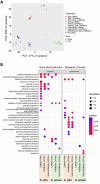This is a preprint.
A methoxylated flavone from Artemisia afra kills Mycobacterium tuberculosis
- PMID: 37873198
- PMCID: PMC10592739
- DOI: 10.1101/2023.10.11.561885
A methoxylated flavone from Artemisia afra kills Mycobacterium tuberculosis
Update in
-
An O-methylflavone from Artemisia afra kills non-replicating hypoxic Mycobacterium tuberculosis.J Ethnopharmacol. 2024 Oct 28;333:118500. doi: 10.1016/j.jep.2024.118500. Epub 2024 Jun 27. J Ethnopharmacol. 2024. PMID: 38944359 Free PMC article.
Abstract
Tuberculosis, caused by Mycobacterium tuberculosis (Mtb), is a deadly and debilitating disease globally affecting millions annually. Emerging drug-resistant Mtb strains endanger the efficacy of the current combination therapies employed to treat tuberculosis; therefore, there is an urgent need to develop novel drugs to combat this disease. Artemisia afra is used traditionally in southern Africa to treat malaria and recently has shown anti tuberculosis activity. This genus synthesizes a prodigious number of phytochemicals, many of which have demonstrated human health effects. Transcriptomic analysis revealed that A. afra exerts different effects on Mtb compared to A. annua or the well-known antimalarial artemisinin, suggesting other phytochemicals present in A. afra with unique modes of action. A biochemometric study of A. afra resulted in the isolation of a methoxylated flavone (1), which displayed considerable activity against Mtb strain mc26230. Compound 1 had an MIC of 312.5 μg/mL and yielded no viable colonies after 6 days of treatment. In addition, 1 was effective in killing hypoxic Mtb cultures, with no viable cultures after 2 days of treatment. This suggested that A. afra is a source of potentially powerful anti-Mtb phytochemicals with novel mechanisms of action.
Figures




References
-
- World Health Organization. Global Tuberculosis Report 2022; WHO, 2022. https://www.who.int/publications-detail-redirect/9789240061729 (accessed 2023–08-28).
-
- World Health Organization. Tuberculosis deaths rise for the first time in more than a decade due to the COVID-19 pandemic. https://www.who.int/news/item/14-10-2021-tuberculosis-deaths-rise-for-th... (accessed 2023–08-30).
-
- Hameed H. M. A.; Islam M. M.; Chhotaray C.; Wang C.; Liu Y.; Tan Y.; Li X.; Tan S.; Delorme V.; Yew W. W.; Liu J.; Zhang T. Molecular Targets Related Drug Resistance Mechanisms in MDR-, XDR-, and TDR-Mycobacterium Tuberculosis Strains. Frontiers in Cellular and Infection Microbiology 2018, 8. - PMC - PubMed
Publication types
Grants and funding
LinkOut - more resources
Full Text Sources
Molecular Biology Databases
